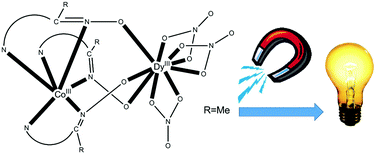“Switching on” the single-molecule magnet properties within a series of dinuclear cobalt(iii)–dysprosium(iii) 2-pyridyloximate complexes†
Abstract
The use of 2-pyridinealdoxime (paoH), methyl 2-pyridyl ketone oxime (mepaoH), phenyl 2-pyridyl ketone oxime (phpaoH) and pyridine-2-amidoxime (NH2paoH) for the synthesis of dinuclear CoIII/DyIII complexes is described in the absence or presence of an external base. Complexes [CoDy(pao)3(NO3)3] (1), [CoDy(mepao)3(NO3)3] (2), [CoDy(phpao)3(NO3)3] (3) and [CoDy(NH2pao)3(NO3)3]·3MeOH (4·3MeOH) have been isolated and their structures have been determined by single-crystal X-ray crystallography. The complexes crystallize in non-centrosymmetric (2, 3) or centrosymmetric (1, 4·3MeOH) trigonal space groups and form a family of triply-oximate bridged dinuclear Co(III)–Dy(III) complexes. The crystals of 1, 3 and 4·3MeOH contain mixtures of Δ and Λ enantiomers, whereas complex 2 is enantiomerically pure (Λ). A 3-fold crystallographic axis (C3) passes through two metal ions in all complexes. The low-spin CoIII and DyIII ions are bridged by three oximate groups belonging to the η1:η1:η1:μ 2-pyridyloximate ligands. The CoIII centre is octahedrally coordinated by the six nitrogen atoms of the deprotonated organic ligands in a facial arrangement. The DyIII centre is bound to an O9 set of donor atoms, its coordination sphere being completed by three bidentate chelating nitrato groups. The coordination polyhedron around DyIII in 1 is best described as the Johnson tricapped trigonal prism, while the coordination geometries of the DyIII centres in 2, 3 and 4·3MeOH are best described as consisting of spherical tricapped trigonal prismatic coordination polyhedra. The spectroscopic data of the complexes are also reported and discussed in the infra-red region in terms of the coordination modes of the ligands involved. The magnetic properties of these complexes were studied between 300 and 1.8 K revealing mainly the depopulation of the DyIIImj sublevels of the ground 6H15/2 state. The intrinsic magnetic anisotropy of the DyIII centers is clearly observed by the non-superimposed magnetization (M) versus H/T data, but single-molecule magnet (SMM) properties were detected only for the mepao−-containing complex 2. The origin of these properties in 2 is critically discussed and supported by computational studies.



 Please wait while we load your content...
Please wait while we load your content...